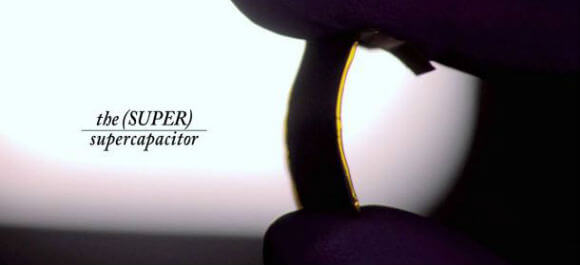The Super Supercapacitor
What if you could charge your phone, tablet, or laptop in 30 seconds and have it work all day long? That's the promise presented in a short film titled The Super Supercapacitor that profiles the work of UCLA inorganic chemistry professor Ric Kaner, whose research focused on conductive polymers and next generation materials.

Share
What if you could charge your phone, tablet, or laptop in 30 seconds and have it work all day long? That's the promise presented in a short film titled The Super Supercapacitor that profiles the work of UCLA inorganic chemistry professor Ric Kaner, whose research focused on conductive polymers and next generation materials.
The story goes that while developing a new way to generate graphene -- the same material used in carbon nanotubes -- Kaner's team made a serendipitous discovery: the new carbon-based material acted as a supercapacitor.
As explained in the short, batteries have high energy storage but slow charging/discharging whereas a capacitor has low energy storage but fast charging/discharging. But what we ideally want for our rechargeable electronic devices is high energy storage and fast charging/discharging, or in other words, the best of both worlds. That is what a supercapacitor delivers, and a carbon-based supercapacitor could replace batteries that contain toxic materials that must be properly disposed of.
You can watch the film to hear Kaner explain how a supercapacitor could change the world:
Be Part of the Future
Sign up to receive top stories about groundbreaking technologies and visionary thinkers from SingularityHub.


The film is part of GE's Focus Forward Films, a project to profile 30 innovative ideas and the people behind them in three-minute films. The Super Supercapacitor was one of 20 finalists in the $200k Filmmaker Competition (we recently covered the SlingShot Purifier, which was also part of GE's competition here).
For the last few years, research on carbon nanotubes and related materials have been focused on as the future of batteries. Bringing the excitement of this research and the potential impact the innovation could have on the world to audiences at film festivals can only help bring awareness about technology and help educate people about science. Furthermore, it helps to humanize scientists and bring accountability to them, as many are at public universities and/or receive grants from public funds.
Still, this work is very much in the research phase and many groups are chasing after the near-unlimited power that supercapacitors may provide. Whether a material acting as a supercapacitor can be created that has a long shelf life and can be scaled up to production levels remains to be seen, but what is clear is that the demand for easy and effective means of charging devices is only going to increase.
The group that solves this problem will have the entire world as its customers.
David started writing for Singularity Hub in 2011 and served as editor-in-chief of the site from 2014 to 2017 and SU vice president of faculty, content, and curriculum from 2017 to 2019. His interests cover digital education, publishing, and media, but he'll always be a chemist at heart.
Related Articles

This Portable Wind Turbine Is the Size of a Water Bottle and Charges Devices in Under an Hour

Mojo Vision’s New Contact Lens Brings Seamless Augmented Reality a Step Closer
The Weird, the Wacky, the Just Plain Cool: Best of CES 2020
What we’re reading
